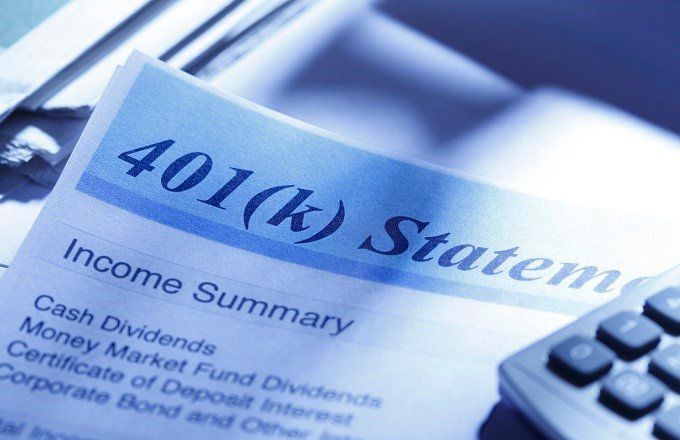
If you are interested in maximizing the growth of your 401(k) plan, you need to know the best way to invest your money. This is where a 401k calculator comes in. The calculator provides information on many factors such as how much you should be contributing, the employer match, the rate of return, and the employer match.
Contribution percentage to the 401k
In 2018, the average American contributed to their 401k plan, or IRA, of almost 8.6%. Although the percentages vary among workers, full-time employees tend to contribute more than part-time workers. The US's total retirement assets will reach $37.2 trillion by 2020, which is 33% of the household equity. At retirement, the average 401k account balance will amount to $93,000. Baby Boomers, Generation X and Generation X are among the most active savers. The generational Z generation was the least active saver, saving only two percent of their incomes in their working years.
Contributions to the 401k account must not exceed 9% your gross salary. If you are over 50, you might consider making a catch up contribution to make up the time lost. It will depend on your retirement plans, lifestyle, and your family's needs. You should consider taking advantage of any company that matches your contribution. Many companies match as much as 50% of the first six per cent of your salary.
401k employer match
It is easy to find out how much your employer will match with your 401k. For example, if you make $50,000 per year, your employer will match up to six percent of your contributions. Your total contribution amount would reach $9,000 This would amount to a half-off match of $4,500. You would then be tax deductible. Use an online calculator to determine the matching amount.

Employer match amounts differ from employer to employee. Some match 100%, others match only a portion. You should know the amount your employer will match to be able to plan accordingly. A typical employer match percentage is 2% of your salary, while a 3% match means that your employer will match your contribution dollar for dollar. Understanding the match amounts will help you to save the right amount for retirement.
Withdrawal frequency for 401k
Your 401k may allow you to choose how often withdrawals are made. You can choose to withdraw from your account weekly, monthly, or quarterly. To account for inflation, you can adjust the withdrawal frequency. The Consumer Price Index in the United States is a common measure of inflation. CPI has averaged 2.9% annually over the past 40 years. CPI is expected at 6.8% annually in 2021.
The Plan Sponsor Council of America says that two-thirds of large 401(k) plans offer the option of regular withdrawals after retirement. This is a convenient feature, even though it can seem cumbersome. However, it allows you to take money out of your account without paying any tax.
Rate of return on 401k contributions
It is important to consider the rate of return for 401k contributions when you are planning your retirement investment. The more consistent your contributions, the greater your average return. When deciding how much to contribute, consider your risk tolerance and how much you can afford to lose if the market strays too far. Your asset allocation is also important. It can be either more conservative or more aggressive depending on your goals.
The overall investment portfolio and the market environment directly influence the rate of return on 401k contribution. With the proper asset allocation, 401(k) contributions can earn anywhere from 3% to 8% annually. Different assets can have different returns, and therefore different risks. For example, stocks and bonds may have a higher return than those with lower risk.

Required minimum distribution from 401k
The Required Minimum Distribution (RMD), is the amount that must be taken from retirement accounts in order to pay taxes. This amount can either be taken from an employer sponsored retirement plan, a traditional IRA (or a SIMPLE or SEP IRA). The RMD requirement has been raised from 70 1/2 to 72 year old in 2020. You should withdraw your money now, even if it's in your 40s.
The IRS has established a minimum distribution amount. It is based primarily on life expectancy. However, you may be able withdraw more than this amount. While this is legal, it can lead to a huge tax bill. Roth IRA accounts are not subject to this requirement, as they are intended for people who plan on retiring while still working.
FAQ
Where To Start Your Search For A Wealth Management Service
The following criteria should be considered when looking for a wealth manager service.
-
Has a proven track record
-
Is the company based locally
-
Consultations are free
-
Continued support
-
Is there a clear fee structure
-
Has a good reputation
-
It is easy to contact
-
You can contact us 24/7
-
Offers a wide range of products
-
Charges low fees
-
Do not charge hidden fees
-
Doesn't require large upfront deposits
-
Have a plan for your finances
-
You have a transparent approach when managing your money
-
Allows you to easily ask questions
-
A solid understanding of your current situation
-
Learn about your goals and targets
-
Is available to work with your regularly
-
Works within your budget
-
A good knowledge of the local market
-
Would you be willing to offer advice on how to modify your portfolio
-
Will you be able to set realistic expectations
What is risk management in investment management?
Risk Management refers to managing risks by assessing potential losses and taking appropriate measures to minimize those losses. It involves monitoring and controlling risk.
A key part of any investment strategy is risk mitigation. The goal of risk-management is to minimize the possibility of loss and maximize the return on investment.
These are the core elements of risk management
-
Identifying the sources of risk
-
Monitoring the risk and measuring it
-
Controlling the Risk
-
How to manage the risk
What are the best strategies to build wealth?
It's important to create an environment where everyone can succeed. You don't need to look for the money. If you're not careful, you'll spend all your time looking for ways to make money instead of creating wealth.
It is also important to avoid going into debt. It is tempting to borrow, but you must repay your debts as soon as possible.
You're setting yourself up to fail if you don't have enough money for your daily living expenses. Failure will mean that you won't have enough money to save for retirement.
It is important to have enough money for your daily living expenses before you start saving.
What is a financial planner? And how can they help you manage your wealth?
A financial planner can help create a plan for your finances. They can analyze your financial situation, find areas of weakness, then suggest ways to improve.
Financial planners are professionals who can help you create a solid financial plan. They can tell you how much money you should save each month, what investments are best for you, and whether borrowing against your home equity is a good idea.
Financial planners typically get paid based the amount of advice that they provide. However, planners may offer services free of charge to clients who meet certain criteria.
What are my options for retirement planning?
No. No. We offer free consultations that will show you what's possible. After that, you can decide to go ahead with our services.
Statistics
- These rates generally reside somewhere around 1% of AUM annually, though rates usually drop as you invest more with the firm. (yahoo.com)
- According to a 2017 study, the average rate of return for real estate over a roughly 150-year period was around eight percent. (fortunebuilders.com)
- US resident who opens a new IBKR Pro individual or joint account receives a 0.25% rate reduction on margin loans. (nerdwallet.com)
- As previously mentioned, according to a 2017 study, stocks were found to be a highly successful investment, with the rate of return averaging around seven percent. (fortunebuilders.com)
External Links
How To
How To Invest Your Savings To Make Money
You can generate capital returns by investing your savings in different investments, such as stocks, mutual funds and bonds, real estate, commodities and gold, or other assets. This is what we call investing. It is important to realize that investing does no guarantee a profit. But it does increase the chance of making profits. There are many ways you can invest your savings. You can invest your savings in stocks, mutual funds, gold, commodities, real estate, bonds, stock, ETFs, or other exchange traded funds. These methods are described below:
Stock Market
Because you can buy shares of companies that offer products or services similar to your own, the stock market is a popular way to invest your savings. Buying stocks also offers diversification which helps protect against financial loss. In the event that oil prices fall dramatically, you may be able to sell shares in your energy company and purchase shares in a company making something else.
Mutual Fund
A mutual funds is a fund that combines money from several individuals or institutions and invests in securities. These mutual funds are professionally managed pools that contain equity, debt, and hybrid securities. The mutual fund's investment objective is usually decided by its board.
Gold
Gold is a valuable asset that can hold its value over time. It is also considered a safe haven for economic uncertainty. It can also be used in certain countries as a currency. Due to investors looking for protection from inflation, gold prices have increased significantly in recent years. The supply/demand fundamentals of gold determine whether the price will rise or fall.
Real Estate
Real estate is land and buildings. When you buy real estate, you own the property and all rights associated with ownership. Rent out part of your home to generate additional income. You can use your home as collateral for loan applications. The home can also be used as collateral for loans. But before you buy any type real estate, consider these factors: location, condition, age, condition, etc.
Commodity
Commodities are raw materials like metals, grains, and agricultural goods. Commodity-related investments will increase in value as these commodities rise in price. Investors who want the opportunity to profit from this trend should learn how to analyze charts, graphs, identify trends, determine the best entry points for their portfolios, and to interpret charts and graphs.
Bonds
BONDS are loans between corporations and governments. A bond can be described as a loan where one or both of the parties agrees to repay the principal at a particular date in return for interest payments. The interest rate drops and bond prices go up, while vice versa. Investors buy bonds to earn interest and then wait for the borrower repay the principal.
Stocks
STOCKS INVOLVE SHARES OF OWNERSHIP IN A COMMUNITY. Shares only represent a fraction of the ownership in a business. If you own 100 shares of XYZ Corp., you are a shareholder, and you get to vote on matters affecting the company. Dividends are also paid out to shareholders when the company makes profits. Dividends are cash distributions to shareholders.
ETFs
An Exchange Traded Fund or ETF is a security, which tracks an index that includes stocks, bonds and currencies as well as commodities and other asset types. ETFs can trade on public exchanges just like stock, unlike traditional mutual funds. The iShares Core S&P 500 eTF (NYSEARCA – SPY), for example, tracks the performance Standard & Poor’s 500 Index. This means that if SPY was purchased, your portfolio would reflect its performance.
Venture Capital
Venture capital is private financing venture capitalists provide entrepreneurs to help them start new businesses. Venture capitalists lend financing to startups that have little or no revenue, and who are also at high risk for failure. Venture capitalists usually invest in early-stage companies such as those just beginning to get off the ground.